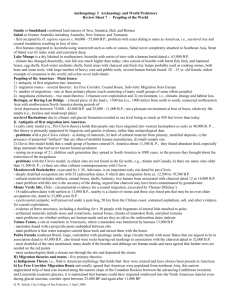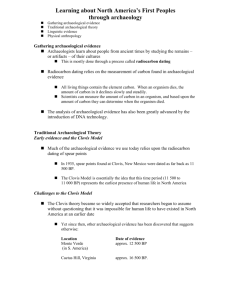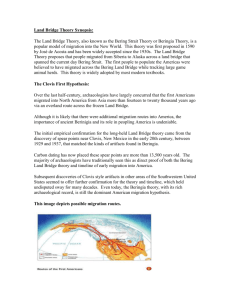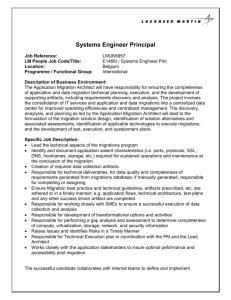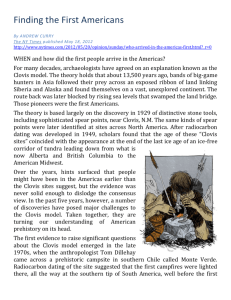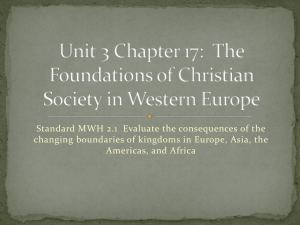MIGRATION AND POPULATION MODELS OF
advertisement
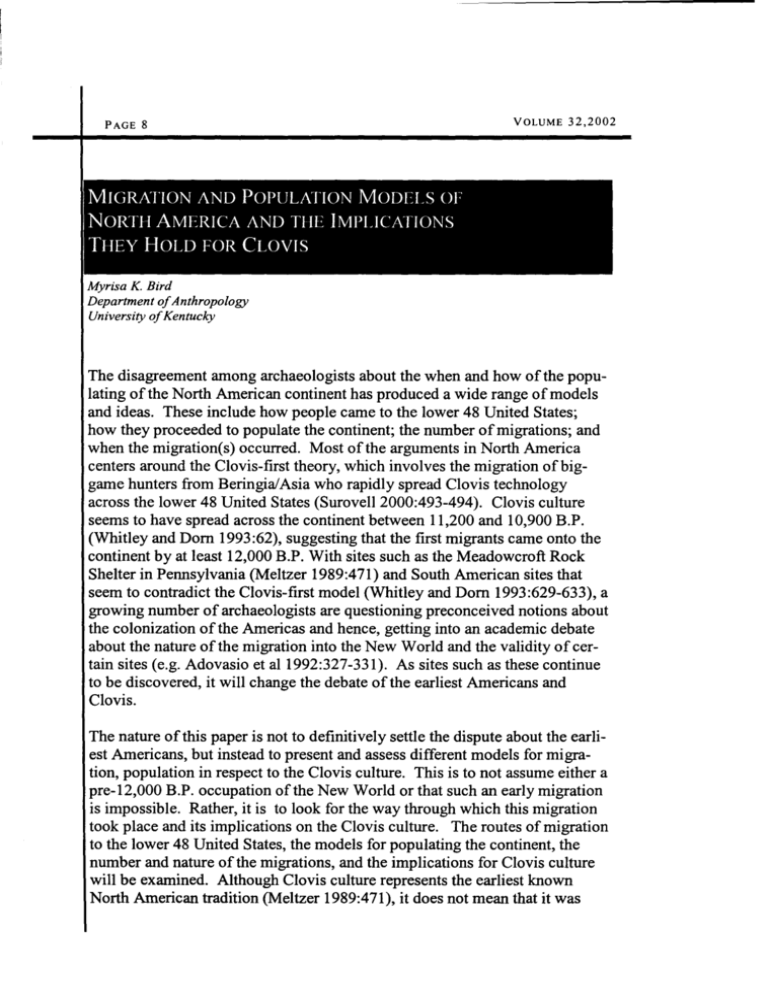
MIGRATION AND POPULATION MODELS OF NORTH AMERICA AND THE lMPLICATIONS THEY HOLD FOR CLOVIS Myrisa K. Bird Department of Anthropology University of Kentucky The disagreement among archaeologists about the when and how of the populating ofthe North American continent has produced a wide range of models and ideas. These include how people came to the lower 48 United States; how they proceeded to populate the continent; the number of migrations; and when the migration(s) occurred. Most of the arguments in North America centers around the Clovis-first theory, which involves the migration of biggame hunters from Beringia/Asia who rapidly spread Clovis technology across the lower 48 United States (Surovell 2000:493-494). Clovis culture seems to have spread across the continent between 11,200 and 10,900 B.P. (Whitley and Dom 1993:62), suggesting that the first migrants came onto the continent by at least 12,000 B.P. With sites such as the Meadowcroft Rock Shelter in Pennsylvania (Meltzer 1989:471) and South American sites that seem to contradict the Clovis-first model (Whitley and Dom 1993:629-633), a growing number of archaeologists are questioning preconceived notions about the colonization ofthe Americas and hence, getting into an academic debate about the nature of the migration into the New World and the validity ofcertain sites (e.g. Adovasio et aI1992:327-331). As sites such as these continue to be discovered, it will change the debate of the earliest Americans and Clovis. The nature ofthis paper is not to definitively settle the dispute about the earliest Americans, but instead to present and assess different models for migration, population in respect to the Clovis culture. This is to not assume either a pre-12,000 B.P. occupation of the New World or that such an early migration is impossible. Rather, it is to look for the way through which this migration took place and its implications on the Clovis culture. The routes of migration to the lower 48 United States, the models for populating the continent, the number and nature of the migrations, and the implications for Clovis culture will be examined. Although Clovis culture represents the earliest known North American tradition (Meltzer 1989:471), it does not mean that it was carried across the continent with the earliest inhabitants, but instead, it may have developed in North America as a specific adaptation, and then spread across the population. The "Ice-free" Corridor and Coastal Migration Beringia, the continuous land area exposed when the Bering Sea level dips below 46 meters from it current levels (Meltzer 1989:474) is generally agreed to be the means by which the first migrants came into North America (Fladmark 1979:55). The final time this lowering of sea level occurred was between 35,000 and 14,400 RP., with Beringia being traversable as late as 10,000 RP. (Bloom 1992; Hopkins 1982). Migration from Beringia to the North American continent would have been possible between 35,000 and 19,000 RP., as well as between 14,000 and 12,000 RP. (Meltzer 1989:474). Until recently, most archaeologists agreed on the use of the "ice-free" corridor to reach what is now the lower 48 United States (Anderson and Gilliam 2000:44). The inhabitability of this corridor, flanked by the Cordilleran and Laurentide ice sheets, is debated by Fladmark (1979:56), who proposes coastal migration as a more reasonable alternative to the "ice-free" corridor. Fladmark (1979:43-44) points to conflicting dates for viable passage through the corridor as an initial sign of weakness in presenting the "ice-free" corridor as a possible route for migrating populations. Even though Anderson and Gillam (2000:49) do approve of the corridor from an ease of entry standpoint, this is based on the traversability of the land, rather than whether or not the corridor was indeed open or inhabitable. The description given by Fladmark (1979:56) of the terrain inside the corridor is one that, if in fact it was unglaciated, is composed of many lakes, possibly biologically dead, as well as a very different environment from that of Beringia, the migrating peoples probable last home. Evidence for "significant biotic communities" in the middle ofthe corridor is also lacking (Fladmark 1979:57). Without these communities, it is unlikely that the proposed terrestrial large game hunters (Diamond 1987:580; Haynes 1982:397) would come across Beringia simply to plunge themselves into the drastically different environment of the "ice-free" corridor, and even less likely that they would have survived the passage through this hostile environment into the lower 48 United States. Along with the objections to traversing the corridor, there is lack of archaeological evidence to support an initial population coming from this route (Fladmark 1979:57). The oldest sites in the lower 48 Untied States do not occur at the margin of the ice sheets as expected, but farther south. Also, on the remaining exposed land of Beringia, there are, as of yet, no sites dated between 25,000 and 13,000 RP. (Fladmark 1979:57), which would seem neces- sary if the migration were to be ancestral to Clovis culture in the appropriate time frame. Obviously, Fladmark's idea about coastal migration needs to be explored in order to explain the populating of North America, especially the United States. To examine the coastal migration theory, the hospitability of the terrain along the coast must first be determined. During the Eagle Creek! Vashon Stade of the last ice age, which ranges from about 19,000 to 15,000 RP., the early evidence suggests that glaciation in the last main ice advance would have been incomplete (Fladmark 1979:58). After extensively reviewing glaciated and unglaciated coastal areas, as well as sea levels, Fladmark (1979:60) concludes that the northwest coast of North America probably closely resembled that of modem-day Greenland, ''with a discontinuous strip of un glaciated terrain along the outer coast and seaward slopes, flanked by glaciers flowing out from mountain sources and from icecaps occupying inner coast and interior basins." Not only were regions often unglaciated, but also six North Pacific areas are said by Heusser (1960) to have had significant floral communities that survived during the last glaciation. These areas generally correspond to the ice-free areas along the coast that are discussed by Fladmark (1979:61). Using floral and faunal studies that date to as early as 15,000 B.P., Fladmark (1979:61) proclaims that not only is the coast inhabitable, but it would be an easier passage than that of the "ice-free" corridor. Lack of archaeological evidence and feasibility are two issues that need to be addressed when discussing coastal migration. As for the archaeological evidence for inhabitation of the coast, Fladmark (1979:62) surmises that rising sea levels would have essentially submerged archaeological deposits left by those living on the coast, or at least reworked the deposits. Fladmark (1979:61) also points out that the lack of migrational archaeological evidence in the "ice-free" corridor is not due to submergence in water or a lack of attempting to find relevant sites supporting the corridor proposal: they are simply not present. Anderson and Gillam (2000:49) point out that Paleoindian people seem to have used watercraft and that the coastal route may have been the only option available to them during many time periods. Johnson (1970) comments that people have been able to use watercraft for 30,000 years, and Fladmark (1979:63) is simply taking the next step, saying that, given his description of the north west coast of North America toward the end of the last ice age, people with "any kind of steerable watercraft" could have navigated down the shoreline. The broader implication of this is that the first people in North America were not terrestrial big-game hunters, but instead already adapted to maritime or semi-maritime lifeways (Fladmark 1979:63). This implies that the Clovis cul- ture was not carried onto the continent with the original migrants, but was a specific lifeway that developed once the North American continent was already beginning to be populated. Populating the North American Continent Three strategies for populating the area that is not the lower 48 United States are Martin's wave migration model, string-of-pearls model, and leap-frog model (Anderson and Gillam 2000:57-59). Martin's model of wave migration, also called the Martin overkill model, assumes a population growth rate of3.4 percent per year, 16 kilometers of movement per year, and an average population density of .4 persons per square kilometer (Mosiman and Martin 1974). Although there have been other wave migration models (e.g. Hassan 1980:201-203 and Haynes 1966), Martin's model for wave migration appears to be the most widely accepted (Whitley and Dorn 1993:627). The string-ofpearls model relies on fissioning of groups and movement into adjacent territories by either the parent or daughter groups created from the break-up of the original group (Anderson and Gillam 2000:57). The leap-frog model also relies on fissioning and movement of groups, but relies on the moving group to go an "appreciable distance" from the parent group (Anthony 1990:902-903). Of these three scenarios, the leap-frog model is most explanatory of current archaeological evidence (Anderson and Gillam 200:58-59). Martin's wave migration overkill model has met with severe criticism, such as Whitley and Dorn (1992:627-629). The reproductive success needed to sustain a 3.4 percent population growth and the mobility without fissioning are not only unlikely, but the analogies Martin uses to get his rates are ill-founded (Whitley and Dorn 1993:627). Martin's analogy for his population growth is based on sedentary fishing village inhabitants of Pitcairn Island during the eighteenth and nineteenth centuries (Martin 1973:970). Using these sedentary fishermen ofthat age to establish population growth for Paleoindian huntergatherers is not acceptable, according to Whitley and Dorn (1993:627). To establish his rate of migration rate of 16 kilometers per years, he draws an analogy from displaced pastoralists fleeing a collapsing Zulu state (Martin 1973:974). Once again, Whitley and Dom (1993:627) rightly argue that this is a bad analogy, considering the migrating people were moving away from a perceived threat and through already occupied territory. It seems that in order for Martin's migration model to work, the Paleoindians migrating across the North American continent would have needed a purpose to move in a forward direction, heading for the coasts, and have had unreasonably high reproductive rates. Even then, the model is still faced with leaving too dense of a population spread across the continent. The string-of-pearls model experiences problems as well (Anderson and Gillam 2000:57), but not to the extent of Martin's overkill model. Since the fissioning bands would have only moved short distances from each other, it would take longer to populate the continent, and also produce population densities too high to be in agreement with archaeological evidence of Paleo indian habitation (Anderson and Gillam 2000:57-58). If archaeological sites were located in a less scattered manner, and the actual migrants had populated North America in a slower manner, then the string-of-pearls model would be indicated. Even if the string-of-pearls model is taken through alternative routes, such as along the coastlines, the migration still does not occur quickly enough, and it does not leave the scattered manner of early population evidenced in the archaeological record (Anderson and Gillam 2000:58). This lack of conformity of the archaeological record is unacceptable when debating a model for population dispersal in the New World. Unfortunately for the proponents of the string-of-pearls model, the archaeological evidence needed to support it is simply not there (Anderson and Gillam 2000:57-58). The leap-frog model more adequately conforms to archaeological evidence, such as the apparent unoccupied areas between Paleoindian sites in North America (Anderson and Gillam 2000:59). As groups fissioned and moved, they would go to what Beaton (1991 :220-222) calls "megapatches," where resources, both biotic and others, are abundant. This would produce a sprinkling of Paleo indian groups across the landscape, and this is indeed what is observed in the archaeological record (Anderson and Gillam 2000:59). This initial sprinkling of groups would have given room for Paleoindian populations to fill in later via future generations (Anderson and Gillam 2000:60). These moves of an "appreciable distance" could also be responsible for the rapid spread of Paleo indian groups across the continent, definitively faster than the string-of-pearls model predicts (Anderson and Gillam 2000:58-59). In reviewing the archaeological data available at this time, the leap-frog model most accurately fits into the understanding of Paleo indian peopling of the New World. Instead of relying on leaving a large population across the landscape, as Martin's overkill model did, or settling near the parent group, as in the string-of-pearls model, the leap-frog model both covers the large distances required in the time allotted and leaves the appropriate scattering of people across the continent. Multiple Migration Evidence and Ideology Given dental, genetic, and linguistic evidence, it seems apparent that there may have been multiple migrations into the North American continent (Greenberg et al. 1986:477). David Meltzer (1989:473-483) points out that regardless of the models proposed for the population of the New World, there is always the possibility of multiple migrations, many of which could have failed and therefore be irrelevant in the discussion of their ancestry to the preEuropean contact populations of North America. Linguistic, genetic, and dental evidence are all used to provide reasons for multiple migrations, most likely three total successful migrations (Meltzer 1989:473-475). According the linguistic analysis, there seem to be three distinct languages groups comprised of the Amerind, Na-Dene, and Eskimo-Aleut (Greenberg et al. 1986; Ruhlen 1987). The Amerind migration is the most closely associated with Clovis (Meltzer 1989:473). These three groups are not easily explained by a single migration, but are indicative of as many as three migrations into the Americas (Greenberg 1987:333). However, this "does not in itself prove that there were three distinct migrations from Asia" (Ruhlen 1987:10). In the most simplistic terms, linguistic evidence points to probably more than one, but definitely no more than three successful migrations into the New World. Although dental and genetic evidence do support the findings of linguistic evidence, it is still not conclusive enough to prove that there were indeed three successful migrations (Meltzer 1989:475). A dribble of migrations, Meltzer (2000:483) believes, may have characterized the peopling of the Americas. These migrations, according to Meltzer (2000:483), could have been either successful or failures, the result of which would be the extinction of the failed population. Although Butzer (1988:201-202) points to gaps in the archaeological record during Paleoindian times as an error in the choice of geological settings by archaeologists, Meltzer (1989:483) proposes that these gaps could be indicative of failed migrations. This dribbling of migrations, many of which may have failed, characterizes Meltzer's view on the populating of the New World. Meltzer (2000:482) further argues that although there may have been a pre-12,000 RP. migration, it does not necessitate that it is ancestral to Clovis culture. In the face of a successful Amerind-Clovis migration, Meltzer (2000:482-484) argues that this means that a migration of non-Clovis ancestors prior to 12,000 RP. could have left scant archaeological evidence, and then become extinct, therefore being insignificant insofar as the actual populating of the Americas. Although Meltzer (1989:473) does suggest genetic and linguistic evidence for multiple migrations onto the North American continent, he suggests that archaeologists must first and foremost rely on the available data from their own discipline, which neither negates nor definitively proves the timing or number of migrations. According to Meltzer (2000:483-484), the greater significance is that there was a group or a coming together of groups that finally comprised Clovis, the earliest defined archaeological complex in North America. Implications for Clovis As indicated in all three preceding sections, it is possible that Clovis culture likely did not come with the colonizers of North America, whether or not the people who would eventually comprise Clovis were the first to arrive on the North American continent. Fladmark (1979:63) argues that the people first to arrive in the lower 48 United States were probably at least semi-maritime adapted, therefore negating the idea of big-game hunters coming through the "ice-free" corridor and expanding across the continent (Diamond 1987:50; Haynes 1982:397; Martin 1987:12-13). While this idea goes against the majority ofthe current archaeological schools of thought, it may, in fact, be very likely. After all, there is the lack of evidence for big game hunting in Beringia and through the "ice-free" corridor (Fladmark 1979:57) for the appropriate times to establish Clovis in the lower 48 continental United States. The ideological success of the leap-frog model according to Anderson and Gillam (2000:59-60) also has ramifications for Clovis. If the leap-frog model is indeed correct, Anderson and Fraught (2000:510-512) argue that Clovis may be more of a regional adaptation from the Southeast, rather then originating from the exit of the "ice-free" corridor. It appears that Clovis was not carried with the initial leap-frog groups, but rather dispersed later, once future generations filled in the territorial gaps between the scattered original groups (Anderson and Gillam 2000:60). Instead of being a carried with founding populations across the hemisphere, the point distribution indicates that it "probably better represents the process of population in-filling and the spread of a specific adaptation" (Anderson and Gillam 2000:60). Using this Model, Clovis is Definitively and adaptation from the lower 48 United States, and probably not from the exit ofthe "ice-free" corridor, as has been previously assumed. Although the theory of multiple migrations or migratory dribbles may seem to have little to do with Clovis, it does state that there could have been other migrations, possibly non-ancestral to Clovis, that came before 12,000 B.P. (Meltzer 1989:484). The possible presence of such peoples does negate the fact that Clovis is indeed the "earliest, well-defined archaeological trace" currently known in North America. Although a handful of sites, such as Meadowcroft Rock Shelter in Pennsylvania, do predate Clovis, this does not nullify Clovis as the earliest recognized culture in North America or deny the fact that Clovis is ancestral to later North American populations in the lower 48 United States (Meltzer 1989:471,484). Conclusion In the preceding, it has been shown that the first inhabitants of North America may not have been large-game hunters but at least semi-maritime adapted (Fladmark 1979:55-65). This idea negates the notion that the first migrants in the New World were already big-game hunters; rather it suggest that that was a later adaptation. This supports the notion of Clovis culture developing after the initial arrival ofthe first Americans. The leap-frog model, with the proposal of Clovis developing out of the southeastern United States, also supports the idea that Clovis culture was developed once the continent had already been populated, if only sparsely (Anderson and Gillam 2000:60; Anderson and Fraught 2000:510-512). Although Meltzer's (1989:476,484) argument for multiple migrations, possibly in a dribbling manner, does not necessarily preclude the development of Clovis culture before the population of North America, he seems to think that it was after the establishment of at least one group and was the result of a specific adaptation. Adovasio, J., J. Donahue, and R. Stuckemrath 1992 Never Say Never Again: Some thoughts on Could Haves and Might Have Beens. American Antiquity 57:327-331. Anderson, D. and M. Faught 2000 Palaeoindian Artefact Distributions: Evidence and Implications. Antiquity 74:507-513. Anderson, D. and J. Gillam 2000 Paleoindian Colonization of the Americas: Implications from an Examination of Physiography, Demography, and Artifact Distribution. American Antiquity 65:43-66. Anthony, D. W. 1990 Migration in Archaeology: The Baby and the Bathwater. American Anthropologist 92:895-914. Beaton, J. M. 1991 Colonizing Continents: Some Problems from Australia and the Americas. In the First Americans: Search and Research, Edited by T. E. Dillehay and D. J. Meltzer, pp. 209-230. CRC Press, Boca Raton, Florida. Bloom, A. 1992 Sea Level and Coastal Morphology of the United States Through the Late Wisconsin Glacial Maximum. In Late Quaternary Environments of the United States: The Late Pleistocene, Edited by S. Porter, pp.215-229. University of Minnesota Press, Minneapolis. Butzer, K. W. 1988 A "Marginality" Model to Explain Major Spatial and Temporal Gaps in the Old and New World Pleistocene Settlement Records. Geoarchaeology 3:193-203. Diamond, J. 1987 Who Were the First Americans? Nature 329:580-581. Fladmark, K.R. 1979 Routes: Alternative Migration Corridors for Early Man in North America American Antiquity 44:55-69. Greenberg, J. H. 1987 Language in the Americas. Stanford. Stanford University Press, Greenberg, J. H., C. G. Turner II, and S. L. Zegura 1986 The Settlement of the Americas: A Comparison of the Linguistic, Dental, and Genetic Evidence. Current Anthropology 27:477-497. Hassan, F. A. 1981 Demographic Archaeology. Academic Press, New York. Haynes, C. V. 1966 Elephant-hunting in North America. Scientific American 214(6):104-112. 1982 Were Clovis Progenitors in Beringia? In Paleoecology of Beringia, edited by D. Hopkins, J. Matthes, C. Schweger, and S. Young, pp. 383-398. Academic Press, New York. Heusser, C. 1960 Late Pleistocene environments of Pacific North America. American Geological Society Special Publication 35. Hopkins, D. 1982 Aspects of the Paleogeography of Beringia During the Late Pleistocene. In Paleoecology of Beringia, edited by D. Hopkins, J. Matthews, C. Schweger, and S. Young, pp.3-28. Johnson, D. L. 1970 The Bering Bridge: not a Prerequisite for late Pleistocene peo pling of the New World. Paper Presented at the thirty-fifth annual meeting of the Society for American Archaeology, Mexico City. Martin, P. S. 1973 The Discovery of America. Science 179:969-974. Meltzer, D. 1989 Why Don't We Know When the First People Came to North America? American Antiquity 54:471-490. Mosimann, J. E., and P.S. Martin 1975 Simulating Overkill by Paleoindians. American Scientist 63:305-313. Surovell, T. 2000 Early Paleoindian Women, Children, Mobility, and Fertility. American Antiquity 65:493-508. Whitley, D. and R. Dom 1993 New Perspectives on the Clovis Vs. Pre-Clovis Controversy. American Antiquity 58:626-647.
